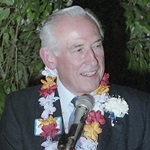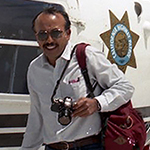Following are excerpts from memories shared by other Loma Prieta Oral History project participants. Each name is linked to that person’s interview.
Elias Avila, a landscape maintenance worker out of Hercules who arrived at the Cypress structure collapse an hour after the earthquake. He helped set up light towers. “I just look at life different now. The way, you know, the awesome power of the Earth.”
Hossein Azizi, a civil engineer out of the Oak Street office in San Francisco, was in his Davis-bound carpool van on the Bay Bridge when the earthquake happened. “After we passed the tunnel, the Treasure Island tunnel, we noticed that traffic is backing up and is almost stopped,” he says. “Traffic was stopped. And people getting out from their cars and vans, whatever they were commuting with, and running back to Treasure Island. Our driver asked, ‘What’s going on?’ They said, ‘The bridge is falling down.’ So we got out and we ran to Treasure Island.”

Burch Bachtold
Burch Bachtold, District 4's director: “I’ve been through several emergencies of this general type over the last 40 years, all of significantly lesser magnitude. You put them all together, they didn’t approach this. But I think, playing just on that experience and that background, that I and the others sort of intuitively did just what the plan would have called for.”
Bob Baxter, the senior transportation engineer at the Cypress Command Center, talks about accompanying President George H.W. Bush as he toured sites damaged by Loma Prieta. “Dan Rather, before the president got here, was here,” Baxter says. “He bulled his way through all of the reporters, making them all very angry, and was looking for somebody to interview with Caltrans. But they pre-empted the Caltrans interview when they got Mayor (Lionel J.) Wilson. … I wasn’t pressed into action, but I was there and ready to talk to the international news, if needed.”
Greg Bayol, public information officer in District 4, is asked how the experience has changed his life. “There is this loss of control feeling. You know, like, it really can happen. It can be taken away from you. The electricity, and the heat, and the hot water, and all these wonderful things are not automatic. They’re fragile. It’s more fragile than you think.”
Mike Chan, an associate transportation engineer based at the Oak Street office: “During the earthquake, I was with 63,000 people at Candlestick Park in the beer line. When it hit, I didn’t think it was that bad. I thought it was like in the 5’s, just like the last one we had. All we were worried about was the beer spilling.”

Bob Colin
Bob Colin, District 4 photographer: “The Cypress structure was unbelievable devastation. It was nearly surreal, what was going on. I immediately started photographing and documenting everything, but it was (pause) the professional side of me doing the work. The emotional side was like disbelief.”
John Godoy, a heavy equipment operator on the Bay Bridge, was assisting a motorist who had run out of gas when the bridge started to move violently. “It got so bad that I looked around and cars were hitting the side of the bridge, losing control. And then it came to a complete stop. Everything came to a complete stop. And I looked to my left, about a hundred feet way, that’s where I saw the dust go up, and I realized something happened on the bridge. So I ran up there, and that’s where the bridge collapsed up in that area. The first thought of my mind was that a ship must have hit the tower up there, and I thought it was going to cause a domino effect, and probably knock down the part I was in, too.”

Ann Hansen
Ann Hansen, deputy district director in charge of operations for District 4 and who in 1951 became one of the first women engineers to join the California Department of Public Works, Division of Highways: “People probably respond better during these times of crisis and stress and perform their best than they do at other times. There’s something, some inner strength, that you pull on that lets you perform very well. That’s not true of everybody. There were people who were a royal pain. You know, pushed you to the point that you lost being nice. [She chuckles.] But others were so great that it more than compensated.”
Pam Keally, a radio room dispatcher, at the time of the earthquake was shopping near her house in Hayward. “I’m standing in the Lucky store, and as the baby food comes crashing down on my right-hand side, and the packets of rice come crashing down on my left, I said to myself, ‘It’s not going to do any good to run. If the ceiling’s going to fall on you and kill you, you may as well just stand here. And I rode it out.”
Shankar Kutty, a transportation engineering technician in the materials lab in San Jose, was alone at work when the earthquake struck. “I ran out and still the shaking was going on. I couldn’t run that fast because when I tried to run, I was going in an angle. … At last I made it under the column of our bridge. Then I waited under the column. I thought the column can save me. But when I looked on the ground, the column is going back and forth at least two inches on either side.”
Susan Simpson, an environmental planner based at Oak Street, lived on the third story of a four-story Victorian in the Lower Haight district. When the earthquake hit, she says, “The room that I was in is a bedroom, and it started to sway, slowly, and then accelerated to a violent shaking. … I ran to the doorway and held on to the doorjamb. Things started to fall off the walls, there was loud crashing all over the house. … Once it stopped, I reconnoitered myself. I was fine. My house was a mess. It was six inches in glass in some places. I was baby sitting a friend’s cat, so I went and rescued the cat out from under the stove and then put it under a box, put it under a doorway, and then I started to hear sirens, all over the city.”
George Smith, a Caltrans surveyor who lived in the East Bay, was miffed about how the Bay Bridge (one death) got more media attention than the Cypress structure (42 deaths). Also: “What bothers me is nobody ever says anything about surveys. You know, the bottom of the barrel is the bottom of the barrel, so be it. But we’ve got people that are out in these areas – hell, their lives are on the line. And no one says anything! All you hear is construction, and design, and all this. But without surveys, you don’t have design.”
Bob Travis, a senior bridge engineer from Sacramento who spent 10 days at the Cypress site, got irritated by all the distractions that kept him and others from doing their jobs. Lots of people showed up unbidden, some were a “university professor or some kind of expert,” he says. “… We had a problem with the fact that we needed to have somebody go around with them. I didn’t feel confident in letting these people wander around there themselves. They may be great theoreticists, but I didn’t think they knew their way around a construction site at all, and I was afraid they’d get run over while they were taking pictures. So, three or four or five days into it we had a problem with manpower again just because we were having our manpower play tour guides.”
John Wood, a lead maintenance worker for District 5 based in Templeton, went with a caravan up north to work on reopening Highway 17. “We didn’t see loss of personal property (or) personal life,” he says. “I felt pretty fortunate. I know some of the other guys from this yard went up there into the East Bay area and saw a lot of that destruction. Like I said, we didn’t see that. I kinda felt good about it. I turned around, I come home, and I didn’t have that to put out of my mind. You know, I didn’t have to deal with that.”

